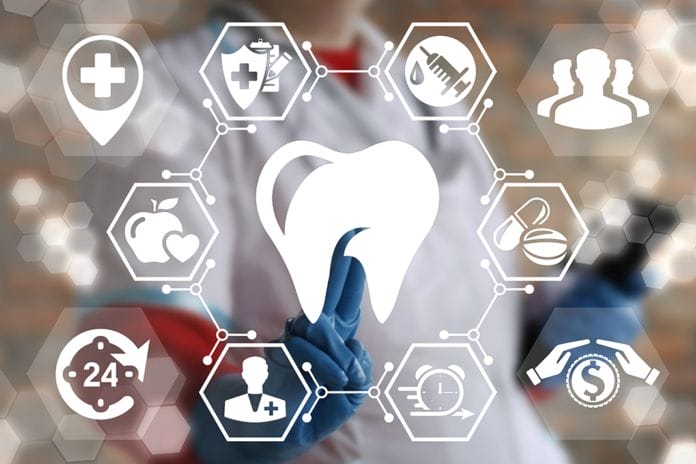The question, “What does my blood pressure have to do with my teeth?” is likely one dental hygienists who take blood pressure have heard. As dental hygienists, we realize the simple answer to this question is a lot; specifically safety while under our treatment and overall health of the patient. Many clinicians have had cases of referring a patient to their general practitioner or even to the emergency room, before undergoing dental treatment due to dangerously high blood pressure. In these cases, dental hygienists are the provider who is responsible for possibly saving that patient’s life.
General medicine and dentistry have been disconnected for hundreds of years.
There is a long history of this beginning in the 1800’s, and with the influx of health insurance, it has continued to increase the divide between the two. Beginning in the 1800’s, mainly in Europe, many medical doctors were beginning to specialize in a variety of fields. One of these was referred to as odontostomatology or the study of the mouth and teeth. As medical doctors continued to specialize, they began to form their own professional associations. Odontostomatologists began to continue to separate from the field of medicine as they wanted the freedom to make their own professional decisions, manners of licensing, professional schools, and methods of reimbursement. Eventually, odontostomatologists were fully divided from the field of medicine; as they no longer attended medical school and began their career in odontostomatology or what became known as dental school.
Once this divide was made, dentists began to lose the respect of their peers as they more commonly became referred to as dentists, which refers to solely the study of teeth and not the oral and medical connection. In the United States, society viewed dentistry as a technical job, being completely separated from medicine. In fact, many barbers and blacksmiths were performing extractions and manufacturing crowns or dentures.
Eventually, society became more regulated, and those working on teeth needed to attend, and receive licensure, at a university level. This led to dental schools forming in the United States. Students attending dental school did not need to have medical training, and professional societies were formed.
As medicine became more regulated with the influx of health insurance in the 1950’s and 60’s dentistry was allowed to flourish as a private business.
As public access to many sources of information through the internet and research studies have become more prevalent, it has become more transparent that medicine and dentistry should not be as divided as they are. Medicine and dentistry are beginning to increase their efforts to communicate with one another and pass this knowledge on to their mutual patients.
Coming full circle, in dentistry, we screen and refer patients based on oral manifestations caused by systemic disease. One simple, yet telling, patient health screening tool is blood pressure. Blood pressure is the first of many diseases that dental hygienists can easily evaluate during a patient’s recall appointment. The entire soft mucosa, tongue, and teeth are all vascular structures affected by the amount of blood flow. Further, patients with increased blood pressure can be at a higher risk for periodontal disease. Patients who are diagnosed with periodontal disease should also be evaluated for high blood pressure signs and symptoms.
Prior to 2003, blood pressure was considered acceptable as long as it was below 139/89. Blood pressure above these numbers was considered prehypertension. Blood pressure of 150/90 was considered hypertension and would need medical intervention or medication. Beginning in 2003, blood pressure guidelines began to change and medicine adjusted the guidelines.
As of 2017, the blood pressure guidelines have further been adjusted. Discussion about a daily blood pressure average, a patient’s full medical history, age, family risk factors, and activity level are all taken into account. Per 2017 guidelines, less than 120/80 is a healthy blood pressure. A blood pressure level between 120/80 and 130/85 is considered prehypertension. Blood pressure from 140-149/90-99 is considered hypertension Class I, and blood pressure above 150/100 is considered hypertension Class II.
In summary, a blood pressure above 120/80 signifies that the patient should be actively changing their diet, increasing their exercise, and monitoring their blood pressure on a regular basis. As dental hygienists, this is a great opportunity for us to monitor patients’ blood pressure at their recall visits and a way for patients to stay accountable for their overall health. Periodontal maintenance patients provide an even greater opportunity for accountability if they are on a 3 to 4-month recall.
One of the first manifestations of many diseases and a sign of decreased health is high blood pressure.
The reasons can vary from obesity, genetic predisposition, heart disease, or other undiagnosed diseases. A quick review: Systolic blood pressure, the higher and top portion of the blood pressure figure, refers to the amount of pressure in arteries when the heart is contracting. Diastolic blood pressure, the lower and bottom portion of the blood pressure figure, refers to blood pressure when the heart is in between beats. The concern of having increased blood pressure is not only that a patient may have an unhealthy lifestyle, but that their heart is working too hard to pump blood. This can lead to an increased risk of stroke and heart attack.
When a patient questions what blood pressure has to do with their teeth, we can begin to make the connection between dentistry and medicine and educate the patient. Although at the moment a patient may not agree or understand the connection; education is the best way to allow a patient to consider the oral-systemic link. If we continue to encourage a patient to observe their medical and dental health jointly, the dental hygiene profession can begin to change the standard we have been trying to overcome.
During a patient’s recall appointment, whether or not a patient has periodontal disease, we can start by asking simple questions about a patient’s health. Some examples of these are whether the patient keeps regular physical appointments or keeps maintenance appointments to monitor their prescriptions with their primary care physician or prescribing physician. We can encourage a patient to maintain a preventive physical care schedule, just as we encourage them to maintain their dental preventive care schedule.
Dental hygienists should keep a record of patient’s primary physician’s address and phone number.
We can even send a record of each patients’ visit to their primary care physician. An example of this might be an update explaining that the patient is maintaining preventive dental care and their blood pressure reading when they were treated in the dental office. We can also make a note to the patient’s primary care physician or prescribing doctor if they have active or stable periodontal disease. If so, we can ask their physician to consider evaluating them for other connections, such as diabetes, which may also increase their risk for periodontal disease. A patient can be at higher risk of not only periodontal disease but diabetes, stroke, and heart attack if they have high blood pressure
Dental hygienists can begin to make the connection to patients’ primary care physicians through each recall appointment, and we can begin to create a relationship between our professions. In the future, as we continue to communicate, we can be hopeful that this will lead to a physician considering the oral health role as it relates to overall health. Hopefully, communication will also help in what medications a physician may prescribe for a patient and help them consider oral side effects. This may also lead to physicians reaching out to us for our dental knowledge in diagnosing many diseases that also have oral manifestations.
As with any change to years of status quo, we must begin with baby steps. By taking baby steps, dental hygienists can lead the way for a future where medicine intertwines with dentistry. Improving the connection between oral health and how it relates to overall health, will not only improve the future and health of our patients, it will improve the health of generations to come.
Need CE? Check Out the Self-Study CE Courses from Today’s RDH!
Listen to the Today’s RDH Dental Hygiene Podcast Below:
References
- Blood Pressure normal? Maybe now it isn’t. Harvard Health Publishing. Harvard Medical School, August 2003.
- Whelton P.K., et al. (2017). Guideline for the Prevention, Detection, Evaluation, and Management of High Blood Pressure in Adults: Executive Summary. Journal of the American College of Cardiology. doi: 10.1016/j.jacc.2017.11.005.
- Vieira, C. and Caramelli, B. (2009). The History of Dentistry and Medicine Relationship: Could the Mouth Finally Return to the Body? Oral Diseases. 15: 538–546. doi:10.1111/j.1601-0825.2009.01589.x
- Weisz, G. Divide and Conquer: A Comparative History of Medical Specialization. New York: Oxford University Press, 2006. Print.
- Otto, Mary. TEETH The Story of Beauty, Inequality, and the Struggle for Oral Health in America. New York: The New Press, 2016. Print.
- Davis, W. WARNING! Normal Blood Pressure May Be High Blood Pressure!” Life Extension Magazine. May 2005. Web. 19 December 2017.
- Rivas-Tumanyan, S., et al. Periodontal Disease, Hypertension and Blood Pressure Among Older Adults in Puerto Rico. J Periodontol. 2013 Feb; 84(2): 203–211.
- Vladeck, B. Universal Health Insurance in the United States: Reflections on the Past, the Present, and the Future. Int J Health Sci (Qassim). 2017 Apr-Jun; 11(2): 72–80.
- Ashraf Nazir, M. Prevalence of Periodontal Disease, Its Association with Systemic Diseases and Prevention. J Appl Oral Sci. 2013 Jan-Feb; 21(1): 1–12.
- Negrato, C.A, et al. Periodontal Disease and Diabetes Mellitus. Published online 2012 May. Am J Public Health. 2003 January; 93(1): 16–19.
- Kane S.F. The Effects of Oral Health on Systemic Health. Gen Dent. 2017 Nov-Dec;65(6):30-34.
- Hamilton, J.A.,et al. Atherosclerosis, Periodontal Disease, and Treatment with Resolvins. Curr Atheroscler Rep.2017 Nov 6;19(12):57. doi: 10.1007/s11883-017-0696-4.












